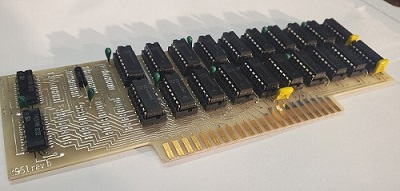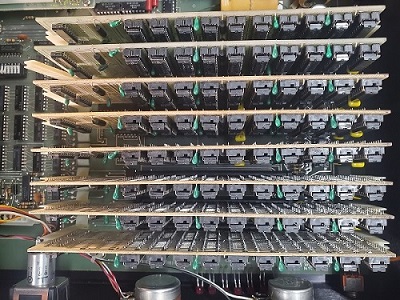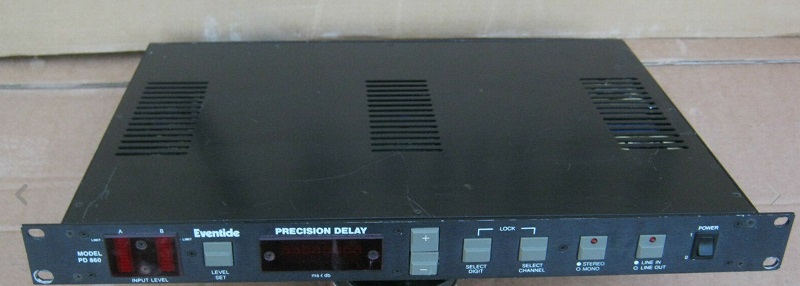The Rest of the Broadcasts
The BD955 Broadcast Delay
Which brings us, somewhat out of temporal order, to the product for which Eventide became almost indispensable to talk radio stations and even to others whose personnel were benignly permitted access to microphones without considering the utterances of their late-night denizens. BLEEP! Yes, the notorious "7-second delay," whose epithet derived from the spacing of the pair of tape recorders required to achieve same in the pre-digital age.
A Feast of Memory
| Eventide, as chronicled in our various flashbacks, feasted on memory. From the 1745 (shift registers) to the 1745A (good and slightly larger shift registers) to the 1745M and H910 (memory chips) to the H949 (bigger and better memory chips) each product generation used more and more memory. By 1977, we concluded that memory was—just barely—inexpensive enough to supplant the space, cost, and inconvenience of the dedicated tape recorders that protected the delicate ears and the even more delicate FCC license coveted by our candidate customers. But what about the BLEEP? Should we add a button to add this irritating, wasteful excrescence to the flow of programming? (Hint: I wouldn't have written "irritating and wasteful" if there weren't a better way.) |  |
| Yum! 16k chips wide by two chips high, this BD955 board boasted two rows of 1977 state-of-the-art memory chips, already twice as many as were in the 1745M delay line or the H949 Harmonizer. Even so you'd have to have a fast trigger finger to bleep your obscenity in the 800 milliseconds of delay this board provided. | |
 |
With an array of eight boards, 800*8 milliseconds could be achieved, long enough to catch a string of four-letter words and even a brief slander. Today, a chip the size of a thumbnail can hold the equivalent amount of data to about a half-million of these boards.
|
What a Stupid Way to Make a Living
The actual purpose of the BLEEP (or brief jingle) that a station would play to eliminate the naughty utterance was to wait for 7 seconds to pass while the delay tape wended its way through the second machine. But if the delay was done digitally, it could disappear in the same address-manipulation computations that the Harmonizer® units used to change pitch. No explosive charge necessary to move the tape heads instantly next to each other. Adding a DUMP button accomplished this as fast as a producer's finger could move! And so our BD-955 digital delay line was introduced to immediate acclaim in the world of talk radio.
 |
- Extra credit for guessing how the product got its name and number. Did BD stand for Broadcast Delay?
- And no credit for guessing the magic feature, since it's described immediately below, that was responsible for a great increment of sales and even a patent action which we would have won had the infringer bothered to go to court.
Catch-Up!
The one problem that still needed to be solved was: What to do after the DUMP? As irritating as the BLEEP was, the program could continue afterwards. Nobody was fooled, but after being discommoded, the host could continue with a different caller, delay still at 7 seconds. DUMPing the profanity left the program flow intact but the station without protection. The problem was how to get the delay back without listeners noticing. The solution turned out to be the pause that increments. Since the now-profanity-free programs were almost always people talking, we took advantage of the fact that (most!) people have natural pauses in their speech. Between words, sentences, speakers, one could always find a time period of a few milliseconds when there was nothing being said. It could be detected electronically and, again using address computation arithmetic, lengthened. As the announcers chatted, the time delay, zero after the DUMP, would build up second by second until the station was protected again. Seeming magic. And great sales.
A sidelight or so: As with most electronic voice manipulation, you can have some fun with it. Although the BD955 didn't change the pitch of the announcer's voice, it did increase the length of pauses. With reasonable control settings, this was barely noticeable—he just seemed to be talking a bit slower. With aggressive control settings, he might sound drunk. Or, using the pre-emptive oscillator setting, drunk and under water! These controls were necessary because a handful of announcers had voices without pauses. The late Allison Steele, who styled herself "The Night Bird," was in that category; we used her broadcasts to calibrate the product.
But...
What a stupid way to make a living! The megabucks of our products, radio and television station fines, and regulatory indigestion caused by profanity and, hopefully its deletion. Wow. Just Wow.
Yet, a nice living it was and to a large extent it remains thus.
A Call for Precision!
There was one other Eventide product designed exclusively for broadcasters. As with the Monstermat, its applications were somewhat esoteric. Remember AM stereo? No, neither does anyone else. In fact very few remember AM at all. AM stands for Amplitude Modulation or as the wags would have it, Ancient Modulation. FM, or Frequency Modulation, has major advantages in terms of listening quality, the most important of which is its relative immunity to noise and interference. AM is in a parlous state now, with many mom and pop stations eking out a precarious existence. FM is doing much better better—possibly even good enough. For AM stations to compete with FM, they needed a system to improve the quality of their sound.
One scheme for rescuing AM was proposed, and it involved a digital delay that required more precision than just a specific number of milliseconds. AM coverage could be improved by adding transmitters! If you're near enough to just one it will overpower the added one. But what if you're in-between, and both signals are similar in strength? If you know where that area is, you can adjust the audio timing with a precision delay so that there is little or no difference in timing of the two signals, and therefore no flanging effects when receiving them both. (Another requirement is for precisely synchronized "carrier" frequencies so there is no "beat note" or a slow amplitude drift as the signals add and subtract from each other.)
Meanwhile, FM was going digital. To avoid obsoleting the hundreds of millions of radio receivers in cars, on tabletops, and in beach-goers pockets, one couldn't simply discontinue the regular FM transmissions. Rather, using the wider bandwidth of each FM channel, digital signals were snuck in so that a special receiver could interpret them as well. But the digital signal took time to process, and there were occasions when the listener's receiver would have to decide whether it or the analog signal would provide a better experience. If it switched from one to the other, or "blended" the two, the time difference in the audio could be several seconds, which would make it impossibly distracting. By delaying the transmitted audio to match the digital time-delayed audio, the switching or blending could be seamless. Again, the delay amount had to be precise to avoid echo or flanging effects.
How precise? Unlike our standard delay products, which could be varied by individual sample intervals of about 20 microseconds, the PD860 could be switched in one-microsecond increments. The specification read "The PD860 precision delay features stereo; 20kHz frequency response; delay adjustable from 15 milliseconds to 5.24438 seconds; adjustable in microsecond increments."
Is That All for Broadcast?
Although the Monstermat, PD860, and its non-existent friends the instant playback unit and card-reader DJ enhancer were included in these flashbacks as part of our portfolio of broadcast products, the BD955 was the first in a long line of profanity delays, with the Model BD600 being its current terminus. And, of course, our Harmonizer effects units found their way into far more production studios than did even the profanity delay products. Broadcasters also used the H949 along with tape-speed controllers to compress the length of programs to fit in more commercials, as described in its own flashback.
The official flashback of this blog (9.2) has more and better photographs and also some words from Jeff Sasmor, who designed the BD955's successor, the BD980.
Ford Does Catch-Up, Too!
A thousand of my millireaders Kirk alerted me to the (pre?)-existence of the Ford 2022 F-150 Lightning truck which seems to embody the PriUPS concept, and Ford is offering it with the accessories necessary to allow the vehicle to power one's home. Ford describes the feature thus:
FORD INTELLIGENT BACKUP POWER
Be prepared for what nature throws at you with the 2022 Ford F-150 Lightning. Available Ford Intelligent Backup Power, enabled by the 80-amp Ford Charge Station Pro, allows you to use your truck as a backup power source to your home during a power outage when home is properly equipped and home transfer switch disconnects home from the grid. The power transfer can be triggered automatically or manually based on customer preference.
Congratulations, Ford! Hopefully this will start a trend. Almost enough to make me less exercised about my warranty issue with their brakes. But only almost. My Feud With Ford is still on.



